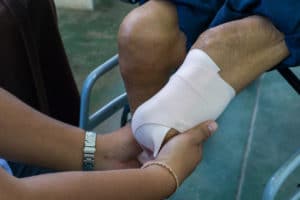Amputation Injury
Home » Personal Injury Resources » Types of Injuries » Amputations

Regardless of which limb you lose, an amputation injury will change your life. You will lose the functionality provided by the lost limb. But you will also deal with ongoing issues with disfigurement, phantom pain, and even emotional issues coming from your injury.
As a result, many amputees require substantial resources to deal with both the immediate effects of their accident and the ongoing issues from their injuries. Fortunately, the damages recoverable after an injury caused by someone else’s negligence can cover most of these losses.
Here is some information about how an amputation injury happens and what you can do to recover compensation.
Table of Contents
What Are the Different Types of Amputation Injuries?

Most amputations in the U.S. do not result from accidents but from disease. Vascular disease, diabetes, cancer, and other medical conditions cause over 55% of amputations. Trauma accounts for about 45% of amputations.
Traumatic amputations happen in two ways:
Surgical Amputations
If your accident causes enough damage to your body part, doctors may recommend amputation. Your cells need a reliable blood supply to survive. They need the oxygen and nutrients delivered by your blood. They also need blood cells to carry waste products like carbon dioxide away.
When any tissue, including bones, lacks circulation, they die. Some cells, like neurons, die within five minutes without oxygen. Your limbs might last six to eight hours. If doctors cannot restore circulation within that time, the cells in your limb will die.
When the cells die, they begin to decompose. These dead and dying cells will poison the rest of your body if doctors do not remove them. In this instance, surgical amputation of your limb will save your life.
Traumatic Amputation
Traumatic amputation happens when your accident severs or tears your body part from you. As mentioned previously, some cells can live up to eight hours without a blood supply. Sometimes, doctors can reattach a limb lost in a traumatic amputation. This is often the case with fingers and toes.
But sometimes, doctors cannot reattach the limb. This could happen for various reasons, including:
- It was severed for too long
- The limb or stump was too badly damaged
- It got contaminated with dirt or chemicals
Reattaching a torn or severed appendage requires hours of surgery while doctors reconnect blood vessels and graft nerves. Even when doctors attempt to reattach a severed limb, the surgery might not succeed. You might require further treatment to surgically amputate the limb.
What Is the Amputation Procedure?
When a limb has been or needs to be amputated, doctors begin by removing the damaged tissue to create a viable stump. Doctors shape the bone, then create a flap to cover it with muscle and skin. They trim and tie off the blood vessels and nerves in the stump.
At the end of the initial amputation surgery, doctors may or may not close the surgery site. If they close the wound, they reduce the odds of an infection. But if they leave it open, they can drain the wound and remove additional tissue if the stump is not viable.
What Amputation Injury Complications Are There?
Amputations can lead to many complications, including:
Contractures
Contractures happen when the muscles or skin shorten due to your surgery and scarring. Contractures limit your range of motion. After an amputation, your muscles and skin might feel tight compared to your intact limb.
Over time, the tissue may stretch and loosen up. The range of motion that you recover will usually depend on your physical therapy.
Infection
You get an infection when bacteria enter your body through an open wound. Once inside your body, the bacteria multiply. The bacteria destroy your cells, causing them to release their contents.
Your body responds by causing the tissue to swell and increase in temperature to trap and kill the bacteria. Between the bacteria and the body’s responses, an infection can make you very ill.
Doctors can treat infections with antibiotics. Without treatment, the bacteria could multiply and spread. If the bacteria move into the amputated bone, you could develop osteomyelitis, a dangerous bone infection.
Edema
An edema is a form of swelling that happens when you retain fluid in your stump. While your body adapts to the amputation, you might have poor circulation in your stump, causing fluid to accumulate.
Doctors recommend using compression dressings to prevent fluid from building up in the stump. They also encourage you to get fitted for a prosthesis as soon as possible so that the prosthesis can help compress the stump.
Phantom Limb Pain
Phantom limb pain affects about 80% of amputees. Phantom pain is not a psychological phenomenon. The pain sensations are real, but your brain uses an outdated map to place them in your missing limb. Over time, the brain will remap itself and place the pain in your stump where your nerve endings now sit.
Emotional Issues
Depression and anxiety are common side effects of an amputation injury. Doctors believe that most cases result from the sense of loss after the amputation and that patients need time to grieve their lost limb.
Are There Amputation Injury Risk Factors?
Almost any type of accident can result in tissue damage that might require amputation. Some examples include:
Motorcycle Accidents
Motorcycle accidents often cause the types of injuries that result in amputation. Severe crush injuries, abrasions, and burns can damage tissue so severely that doctors will consider amputation.
Pedestrian Accidents
Pedestrians have little protection when they get hit by a car. The damage caused by a pedestrian accident can include shattered bones, torn blood vessels, and severed nerves. Oftentimes, doctors will amputate to save the patient’s life.
Can I Get Compensation for an Amputation Injury?
California law gives you the right to seek compensation for an amputation injury that results from the intentional or negligent actions of others. When you successfully prove liability for your amputation injury, you can potentially recover compensation for your economic and non-economic losses.
Economic damages include your medical bills, lost income, and other financial losses. Non-economic damages cover the reduction in your quality of life due to your injuries.In the case of an amputation injury, the permanent loss of your appendage could justify substantial damages. Contact the M&Y Personal Injury Lawyers for a free consultation to discuss the damages you can seek for your amputation injury.
